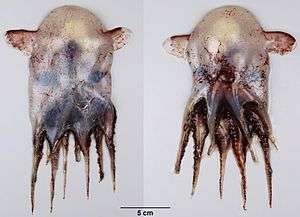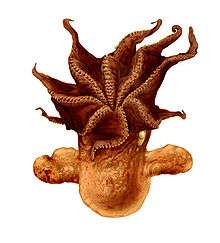Grimpoteuthis
| Grimpoteuthis | |
|---|---|
.jpg) | |
| Scientific classification | |
| Kingdom: | Animalia |
| Phylum: | Mollusca |
| Class: | Cephalopoda |
| Order: | Octopoda |
| Family: | Opisthoteuthidae |
| Genus: | Grimpoteuthis Robson, 1932 |
| Type species | |
| Cirroteuthis umbellata Fischer, 1884 | |
| Species | |
|
14, see text | |
Grimpoteuthis is a genus of pelagic umbrella octopuses known as the dumbo octopuses.[1] The name "dumbo" originates from their resemblance to the title character of Disney's 1941 film Dumbo, having a prominent ear-like fin which extends from the mantle above each eye. There are 13 species recognized in the genus.[2] Prey include crustaceans, bivalves, worms and copepods.[1] The average life span of various Grimpoteuthis species is 3 to 5 years.

Most species of Grimpoteuthis live at depths of at least 3,000 to 4,000 metres (9,800 to 13,100 ft) with some living up to 7,000 metres (23,000 ft) below sea level, which is the deepest of any known octopus.[3] They are some of the rarest of the Octopoda species though they occur worldwide including in the waters of New Zealand, Australia, Monterey Bay, Oregon, Philippines, Martha's Vineyard, Papua New Guinea and Azores. The largest dumbo octopus ever recorded was 1.8 metres (5.9 ft) in length and weighed 5.9 kilograms (13 lb).[4] The average size for most species is 20–30 centimetres (7.9–12 in) in length. The average weight is still undetermined.
Species
- Grimpoteuthis abyssicola O'Shea, 1999, red jellyhead
- Grimpoteuthis bathynectes Voss & Pearcy, 1990
- Grimpoteuthis boylei Collins, 2003
- Grimpoteuthis challengeri Collins, 2003
- Grimpoteuthis discoveryi Collins, 2003
- Grimpoteuthis hippocrepium (Hoyle, 1904)
- Grimpoteuthis innominata (O'Shea, 1999), small jellyhead
- Grimpoteuthis meangensis (Hoyle, 1885)
- Grimpoteuthis megaptera (Verrill, 1885)
- Grimpoteuthis pacifica (Hoyle, 1885)
- Grimpoteuthis plena (Verrill, 1885)
- Grimpoteuthis tuftsi Voss & Pearcy, 1990
- Grimpoteuthis umbellata (P. Fischer, 1884)
- Grimpoteuthis wuelkeri (Grimpe, 1920)' – possibly same as G. umbellata or G. plena
Several species formerly classified in this genus were moved to other opisthoteuthid genera.[5]
Range and habitat
Species of Grimpoteuthis are assumed to have a worldwide distribution, living in the cold, abyssal depths ranging from 1000 to 4,800 metres (13,000 ft). Specimens have been found off the coast of Oregon, The Philippines, Martha's Vineyard, Azores, New Zealand, Australia, California, Papua, and New Guinea. Dumbo octopuses are among the deepest living octopuses known.
Threats
Species of Grimpoteuthis face few direct threats from humans, living at depths of 1,000 meters (3,300 ft) and below. Natural predators include sharks and predatory cephalopods.
Movement
The genus has a distinct habit of swimming. They flap their ear-like fins to propel themselves. Movement of the arms can be used to help the animal move in any direction. The arms permit the animal to crawl along the seafloor, to capture prey, lay eggs, explore, etc. Dumbos hover above the sea floor, searching for polychaete worms, pelagic copepods, isopods, amphipods, and other crustaceans for food.[6] Prey is captured by pouncing on the target, which then is swallowed whole.[3]
Breeding
Females have no distinct period for breeding. Females carry multiple eggs in various stages of maturation, suggesting that they have no optimal breeding period. Male octopuses have a separate protuberance on one of their arms that carries an encapsulated sperm packet to the female. It is hypothesized that the female can then distribute this sperm to the eggs at any given time based on environmental conditions. The females lay the eggs under small rocks or on shells in the deep ocean or can even carry them on her arms, by tucking the eggs behind the wide webbing, until she finds a safe place that would provide them with the best fitness. As with other octopuses, females do not invest any further time in the young after they hatch because once they are born they are able to defend themselves.
References
- 1 2 "Finned Deep-sea Octopuses". Marinebio. Retrieved 8 May 2014.
- ↑ Young, Richard. "Grimpoteuthis". Retrieved 10 May 2014.
- 1 2 "Dumbo Octopus". Aquarium of the Pacific.
- ↑ "NOAA Researchers, Ships Participate in Census of Marine Life's Decade of Discovery" (Press release). National Oceanic and Atmospheric Administration. November 23, 2009. Retrieved May 11, 2011.
- ↑ Collins, Martin A. (2003). "The genus Grimpoteuthis (Octopoda: Grimpoteuthidae) in the north-east Atlantic, with descriptions of three new species". Zoological Journal of the Linnean Society. 139: 93–127. doi:10.1046/j.1096-3642.2003.00074.x.
- ↑ Collins, M.A. & R. Villaneuva. (2006). Taxonomy, ecology and behaviour of the cirrate octopods. In: Gibson, R.N., R.J.A. Atkinson & J.D.M. Gordon (eds.) Oceanography and Marine Biology: An Annual Review, Volume 44. Taylor and Francis, London. pp. 277–322.
External links
- Dumbo Octopus video at BBC
